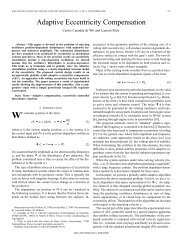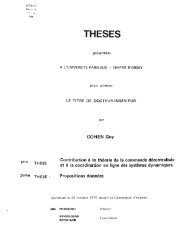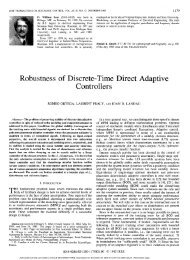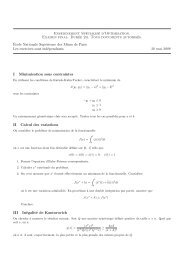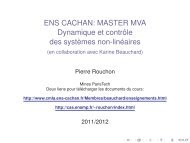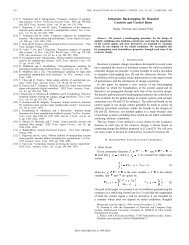HOMOGENEOUS OBSERVER DESIGN 1823The pro<strong>of</strong> <strong>is</strong> given in Appendix G.Example 2.23. An interesting case, which can be dealt with <strong>by</strong> Corollary 2.22, <strong>is</strong>when the δ i ’s are outputs <strong>of</strong> auxiliary systems with state z i in R ni , i.e.,(2.13) δ i (t) := δ i (z i (t),x(t)), ż i = g i (z i ,x) .It can be checked that the bounds (2.11) and (2.10) are sat<strong>is</strong>fied <strong>by</strong> all the solutions<strong>of</strong> (2.8) and (2.13) if there ex<strong>is</strong>t positive definite and radially unbounded functionsZ i : R ni → R + ; class K functions ω 1 , ω 2 , and ω 3 ; and a positive real number ɛ in(0, 1) such that for all x in R n , for all i in {1,...,m}, and z i in R ni , we have∂Z i|δ i (z i ,x)| ≤ ω 1 (x)+ω 2 (Z i (z i )), (z i ) g i (z i ,x) ≤ −Z i (z i )+ω 3 (|x|) ,∂z iω 1 (x)+ω 2 ([1 + ɛ] ω 3 (|x|)) ≤ c G H ( )|x| r0,ir 0, |x| r∞,ir ∞ .Another important result exploiting Theorem 2.20 deals with finite time convergence<strong>of</strong> solutions toward a globally asymptotically stable equilibrium (see [4]). It <strong>is</strong>well known that when the origin <strong>of</strong> the homogeneous approximation in the 0-limit<strong>is</strong> globally asymptotically stable with a strictly negative degree, then solutions convergeto the origin in finite time (see [3]). We extend <strong>th<strong>is</strong></strong> result <strong>by</strong> showing that if,furthermore, the origin <strong>of</strong> the homogeneous approximation in the ∞-limit <strong>is</strong> globallyasymptotically stable with strictly positive degree, then the convergence time doesn’tdepend on the initial condition. Th<strong>is</strong> <strong>is</strong> expressed <strong>by</strong> the following corollary.Corollary 2.24 (uniform and finite time convergence). Under the hypotheses<strong>of</strong> Theorem 2.20, if we have d ∞ > 0 > d 0 , then all solutions <strong>of</strong> the system ẋ = f(x)converge in finite time to the origin, uniformly in the initial condition.The pro<strong>of</strong> <strong>is</strong> given in Appendix H.3. Recursive observer design for a chain <strong>of</strong> integrators. The notion <strong>of</strong>homogeneity in the bi-limit <strong>is</strong> instrumental in introducing a new observer designmethod. Throughout <strong>th<strong>is</strong></strong> section we consider a chain <strong>of</strong> integrators, with state X n =(X 1,...,X n) in R n , namely,(3.1) Ẋ 1 = X 2 , . . . , Ẋ n = u, or in compact form, Ẋ n = S n X n + B n u,where S n <strong>is</strong> the shift matrix <strong>of</strong> order n, i.e., S n X n = (X 2,...,X n, 0) T and B n =(0,...,0, 1) T 1. By selecting arbitrary vector field degrees d 0 and d ∞ in (−1,n−1), wesee that, to possibly obtain homogeneity in the bi-limit <strong>of</strong> the associated vector field,we must choose the weights r 0 =(r 0,1 ,...,r 0,n ) and r ∞ =(r ∞,1 ,...,r ∞,n ) as(3.2)r 0,n = 1 , r 0,i = r 0,i+1 − d 0 = 1 − d 0 (n − i) ,r ∞,n = 1 , r ∞,i = r ∞,i+1 − d ∞ = 1 − d ∞ (n − i) .The goal <strong>of</strong> <strong>th<strong>is</strong></strong> section <strong>is</strong> to introduce a global homogeneous in the bi-limit observerfor the system (3.1). Th<strong>is</strong> design follows a recursive method, which constitutes one <strong>of</strong>the main contributions <strong>of</strong> <strong>th<strong>is</strong></strong> paper.The idea <strong>of</strong> designing an observer recursively starting from X n and going backwardstowards X 1 <strong>is</strong> not new. It can be found, for instance, in [28, 26, 23, 30, 35] andin [7, Lemma 6.2.1]. Nevertheless, the procedure we propose <strong>is</strong> new and extends theresults in [23, Lemmas 1 and 2] to the homogeneous in the bi-limit case.<strong>Copyright</strong> © <strong>by</strong> <strong>SIAM</strong>. <strong>Unauthorized</strong> <strong>reproduction</strong> <strong>of</strong> <strong>th<strong>is</strong></strong> <strong>article</strong> <strong>is</strong> prohibited.
1824 V. ANDRIEU, L. PRALY, AND A. ASTOLFIAlso, as opposed to what <strong>is</strong> proposed in [28, 26], 5 <strong>th<strong>is</strong></strong> observer <strong>is</strong> an exact observer(with any input u) for a chain <strong>of</strong> integrators. The observer <strong>is</strong> given <strong>by</strong> the system 6(3.3)˙ˆX n = S n ˆXn + B n u + K 1 (ˆX 1 − X 1) ,with state ˆX n = (ˆX 1,...,ˆX n), and where K 1 : R n → R n <strong>is</strong> a homogeneous in thebi-limit vector field with weights r 0 , r ∞ and degrees d 0 , d ∞ . The output injectionvector field K 1 has to be selected such that the origin <strong>is</strong> a globally asymptoticallystable equilibrium for the system(3.4) Ė 1 = S n E 1 + K 1 (e 1 ), E 1 = (e 1 ,...,e n ) T ,and also for its homogeneous approximations. The construction <strong>of</strong> K 1 <strong>is</strong> performedvia a recursive procedure whose induction argument <strong>is</strong> as follows.Consider the system on R n−i given <strong>by</strong>(3.5) Ė i+1 = S n−i E i+1 + K i+1 (e i+1 ), E i+1 =(e i+1 ,...,e n ) T ,with S n−i the shift matrix <strong>of</strong> order n − i, i.e., S n−i E i+1 =(e i+2 ,...,e n , 0) T , andK i+1 : R n−i → R n−i a homogeneous in the bi-limit vector field, whose associatedtriples are ((r 0,i+1 ,...,r 0,n ), d 0 ,K i+1,0 ) and ((r ∞,i+1 ,...,r ∞,n ), d ∞ ,K i+1,∞ ).Theorem 3.1 (homogeneous in the bi-limit observer design). Consider the system(3.5) and its homogeneous approximation at infinity and around the origin,Ė i+1 = S n−i E i+1 + K i+1,0 (e i+1 ), Ė i+1 = S n−i E i+1 + K i+1,∞ (e i+1 ) .Suppose the origin <strong>is</strong> a globally asymptotically stable equilibrium for these systems.Then there ex<strong>is</strong>ts a homogeneous in the bi-limit vector field K i : R n−i+1 → R n−i+1 ,with associated triples ((r 0,i ,...,r 0,n ), d 0 ,K i,0 ) and ((r ∞,i ,...,r ∞,n ), d ∞ ,K i,∞ ), suchthat the origin <strong>is</strong> a globally asymptotically stable equilibrium for the systems(3.6)Ė i = S n−i+1 E i + K i (e i ) ,Ė i = S n−i+1 E i + K i,0 (e i ), E i =(e i ,...,e n ) T ,Ė i = S n−i+1 E i + K i,∞ (e i ) .Pro<strong>of</strong>. We prove <strong>th<strong>is</strong></strong> result in two steps. First, we define a homogeneous in thebi-limit Lyapunov function. Then we construct the vector field K i , depending on aparameter l which, if sufficiently large, renders negative definite the derivative <strong>of</strong> <strong>th<strong>is</strong></strong>Lyapunov function along the solutions <strong>of</strong> the system.Step 1. Definition <strong>of</strong> the Lyapunov function. Let d W0 and d W∞ be positive realnumbers sat<strong>is</strong>fying(3.7) d W0 > 2 max 1≤j≤ n r 0,j + d 0 , d W∞ > 2 max 1≤j≤ n r ∞,j + d ∞ ,and(3.8)d W∞r ∞,i≥ d W 0r 0,i.5 Note the term x i in (3.15) <strong>of</strong> [28], for instance.6 To simplify the presentation, we use the compact notation K 1 (ˆX 1−X 1) for K 1 (ˆX 1−X 1, 0,...,0).<strong>Copyright</strong> © <strong>by</strong> <strong>SIAM</strong>. <strong>Unauthorized</strong> <strong>reproduction</strong> <strong>of</strong> <strong>th<strong>is</strong></strong> <strong>article</strong> <strong>is</strong> prohibited.
- Page 1 and 2: SIAM J. CONTROL OPTIM.Vol. 47, No.
- Page 3 and 4: 1816 V. ANDRIEU, L. PRALY, AND A. A
- Page 5 and 6: 1818 V. ANDRIEU, L. PRALY, AND A. A
- Page 7 and 8: 1820 V. ANDRIEU, L. PRALY, AND A. A
- Page 9: 1822 V. ANDRIEU, L. PRALY, AND A. A
- Page 13 and 14: 1826 V. ANDRIEU, L. PRALY, AND A. A
- Page 15 and 16: 1828 V. ANDRIEU, L. PRALY, AND A. A
- Page 17 and 18: 1830 V. ANDRIEU, L. PRALY, AND A. A
- Page 19 and 20: 1832 V. ANDRIEU, L. PRALY, AND A. A
- Page 21 and 22: 1834 V. ANDRIEU, L. PRALY, AND A. A
- Page 23 and 24: 1836 V. ANDRIEU, L. PRALY, AND A. A
- Page 25 and 26: 1838 V. ANDRIEU, L. PRALY, AND A. A
- Page 27 and 28: 1840 V. ANDRIEU, L. PRALY, AND A. A
- Page 29 and 30: 1842 V. ANDRIEU, L. PRALY, AND A. A
- Page 31 and 32: 1844 V. ANDRIEU, L. PRALY, AND A. A
- Page 33 and 34: 1846 V. ANDRIEU, L. PRALY, AND A. A
- Page 35 and 36: 1848 V. ANDRIEU, L. PRALY, AND A. A
- Page 37: 1850 V. ANDRIEU, L. PRALY, AND A. A




